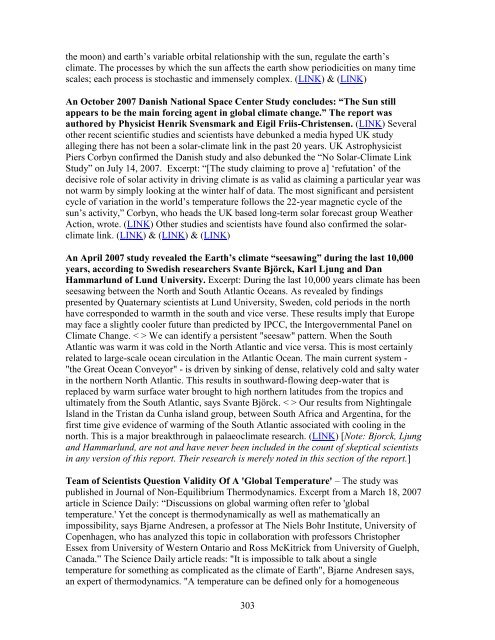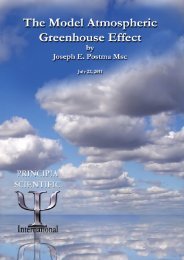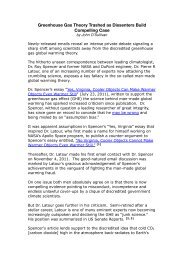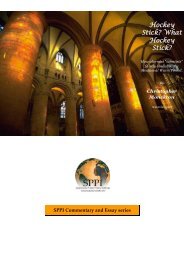Than 1000 International Scientists Dissent Over Man-Made Global ...
Than 1000 International Scientists Dissent Over Man-Made Global ...
Than 1000 International Scientists Dissent Over Man-Made Global ...
You also want an ePaper? Increase the reach of your titles
YUMPU automatically turns print PDFs into web optimized ePapers that Google loves.
the moon) and earth‘s variable orbital relationship with the sun, regulate the earth‘s<br />
climate. The processes by which the sun affects the earth show periodicities on many time<br />
scales; each process is stochastic and immensely complex. (LINK) & (LINK)<br />
An October 2007 Danish National Space Center Study concludes: “The Sun still<br />
appears to be the main forcing agent in global climate change.” The report was<br />
authored by Physicist Henrik Svensmark and Eigil Friis-Christensen. (LINK) Several<br />
other recent scientific studies and scientists have debunked a media hyped UK study<br />
alleging there has not been a solar-climate link in the past 20 years. UK Astrophysicist<br />
Piers Corbyn confirmed the Danish study and also debunked the ―No Solar-Climate Link<br />
Study‖ on July 14, 2007. Excerpt: ―[The study claiming to prove a] ‗refutation‘ of the<br />
decisive role of solar activity in driving climate is as valid as claiming a particular year was<br />
not warm by simply looking at the winter half of data. The most significant and persistent<br />
cycle of variation in the world‘s temperature follows the 22-year magnetic cycle of the<br />
sun‘s activity,‖ Corbyn, who heads the UK based long-term solar forecast group Weather<br />
Action, wrote. (LINK) Other studies and scientists have found also confirmed the solarclimate<br />
link. (LINK) & (LINK) & (LINK)<br />
An April 2007 study revealed the Earth‟s climate “seesawing” during the last 10,000<br />
years, according to Swedish researchers Svante Björck, Karl Ljung and Dan<br />
Hammarlund of Lund University. Excerpt: During the last 10,000 years climate has been<br />
seesawing between the North and South Atlantic Oceans. As revealed by findings<br />
presented by Quaternary scientists at Lund University, Sweden, cold periods in the north<br />
have corresponded to warmth in the south and vice verse. These results imply that Europe<br />
may face a slightly cooler future than predicted by IPCC, the Intergovernmental Panel on<br />
Climate Change. < > We can identify a persistent "seesaw" pattern. When the South<br />
Atlantic was warm it was cold in the North Atlantic and vice versa. This is most certainly<br />
related to large-scale ocean circulation in the Atlantic Ocean. The main current system -<br />
"the Great Ocean Conveyor" - is driven by sinking of dense, relatively cold and salty water<br />
in the northern North Atlantic. This results in southward-flowing deep-water that is<br />
replaced by warm surface water brought to high northern latitudes from the tropics and<br />
ultimately from the South Atlantic, says Svante Björck. < > Our results from Nightingale<br />
Island in the Tristan da Cunha island group, between South Africa and Argentina, for the<br />
first time give evidence of warming of the South Atlantic associated with cooling in the<br />
north. This is a major breakthrough in palaeoclimate research. (LINK) [Note: Bjorck, Ljung<br />
and Hammarlund, are not and have never been included in the count of skeptical scientists<br />
in any version of this report. Their research is merely noted in this section of the report.]<br />
Team of <strong>Scientists</strong> Question Validity Of A '<strong>Global</strong> Temperature' – The study was<br />
published in Journal of Non-Equilibrium Thermodynamics. Excerpt from a March 18, 2007<br />
article in Science Daily: ―Discussions on global warming often refer to 'global<br />
temperature.' Yet the concept is thermodynamically as well as mathematically an<br />
impossibility, says Bjarne Andresen, a professor at The Niels Bohr Institute, University of<br />
Copenhagen, who has analyzed this topic in collaboration with professors Christopher<br />
Essex from University of Western Ontario and Ross McKitrick from University of Guelph,<br />
Canada.‖ The Science Daily article reads: "It is impossible to talk about a single<br />
temperature for something as complicated as the climate of Earth", Bjarne Andresen says,<br />
an expert of thermodynamics. "A temperature can be defined only for a homogeneous<br />
303





